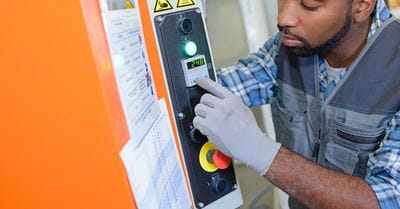Vertical Reciprocating Conveyors | Stockton

Raymond West supplies warehouse automation equipment such as VRC's.
We are among the largest suppliers of warehouse automation equipment in the state.
Call us today at (800) 675-2500.
What Is a Vertical Reciprocating Conveyor (VRC)?
A VRC is an efficient, relatively inexpensive, convenient means to move materials from one level to another. VRCs have applications in many different industries, including manufacturing plants, storage facilities, distribution centers, and other multi-story facilities. These versatile pieces of equipment can be readily incorporated into a structure’s basement, mezzanine, balcony or any upper floor levels.
VRC’s are made up of a column, a carriage, and a hydraulic or mechanical system. Vertical material lifts can be installed just about anywhere inside or outside of a structure. Gates and cages encircling VRC shafts keep workers safe and prevent accidents.
What Are Some Advantages of VRCs?
Safety: Many operations rely on lift trucks to move their materials and merchandise from one level to another. While ideal for moving many different materials, lift trucks are mainly intended for the horizontal movement of goods. In the name of efficiency, workers may sometimes take their forklifts beyond their vertical limit or move loads beyond their truck’s capacity rating. When these transgressions occur, the likelihood of an accident multiply.
For some vertical product movement, VRCs offer a safe and effective replacement for lift trucks. Specifically engineered and built for each operation’s application requirements, VRCs substantially minimize the possibility of human error.
Additionally, VRCs are built to lift more substantial loads more frequently. These faster throughput rates result in less labor expenses. For operations that have routine vertical transport requirements, vertical reciprocating conveyors can improve worker safety and decrease costs.
Customization: One significant benefit to vertical reciprocating conveyors is the extent to which they can be adapted to unique requirements. Because passenger elevators are designed to safely move people, there are numerous regulations that limit the weight capacity, speed and size of these mechanisms. Although such safeguards are necessary and advisable for safely transporting humans, they are not necessary for high volume movement of materials in manufacturing plants, warehouses and distribution operations. Vertical lifts can be readily customized due to the fact that they are not saddled with the same laws as passenger elevators.
Regulation: Vertical reciprocating conveyors are designed to move freight only, while elevators are meant to move both humans and cargo. Due to this important difference, VRCs are exempt from the strict elevator standards in many states.
In place of local jurisdiction, VRCs are regulated by their own universal code that is overseen by the American Society of Mechanical Engineers (ASME), one of the preeminent standards defining associations in the country. More specifically, vertical reciprocating conveyors must comply with ASME’s Safety Standard for Conveyor and Related Equipment (ASME B20.1-2018). This standard outlines the requirements for the fabrication, installation, operating procedure and maintenance of conveyor systems.
Raymond West Is A Full Service Supplier of Vertical Reciprocating Conveyors
If you’re in the market for a VRC, have questions or require engineering support, Raymond West can give you a hand. Our conveyor system experts can help design, procure, set up and service a system that’s right for your business. Give us a call today!
Raymond West's Stockton facility serves much of the northern Central Valley, including Stockton, Lathrop, Lodi, Tracy, Modesto, and Merced.
Raymond West | Stockton Material Handling Equipment Supplier
19107 Christopher Way
Lathrop, CA 95330
(800) 675-2500

